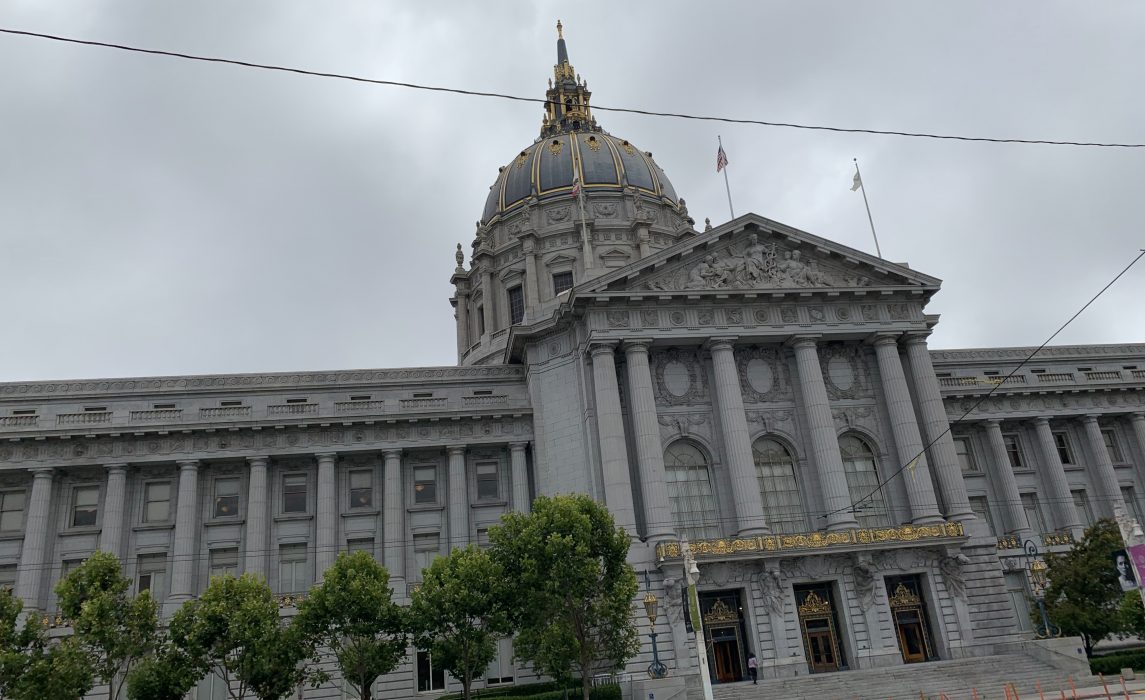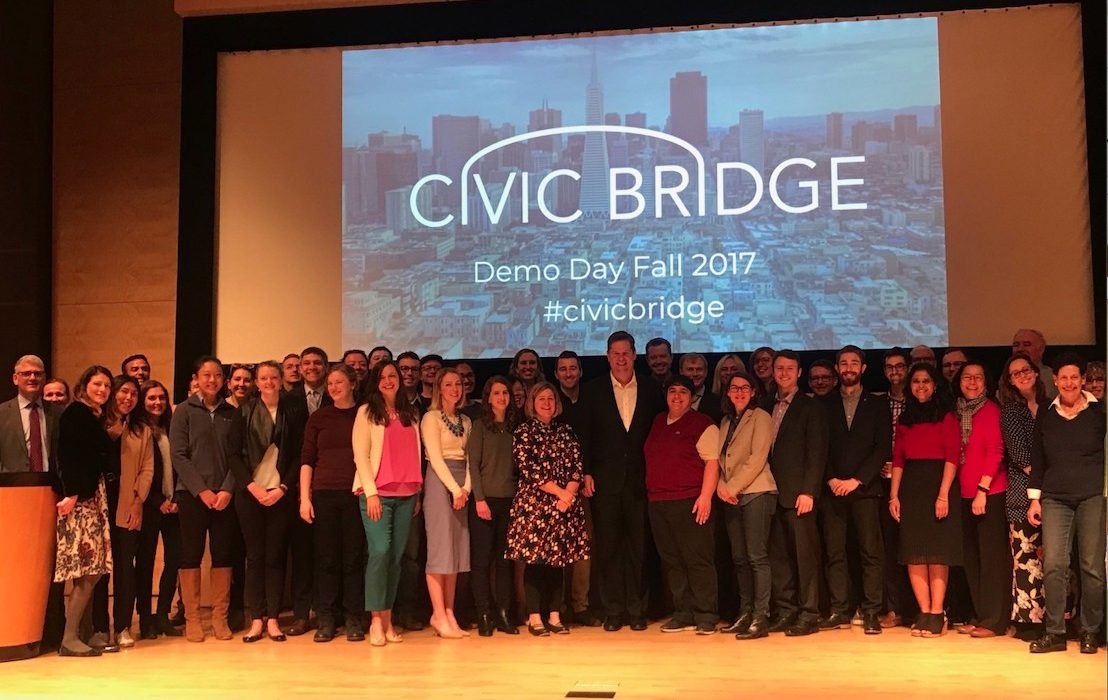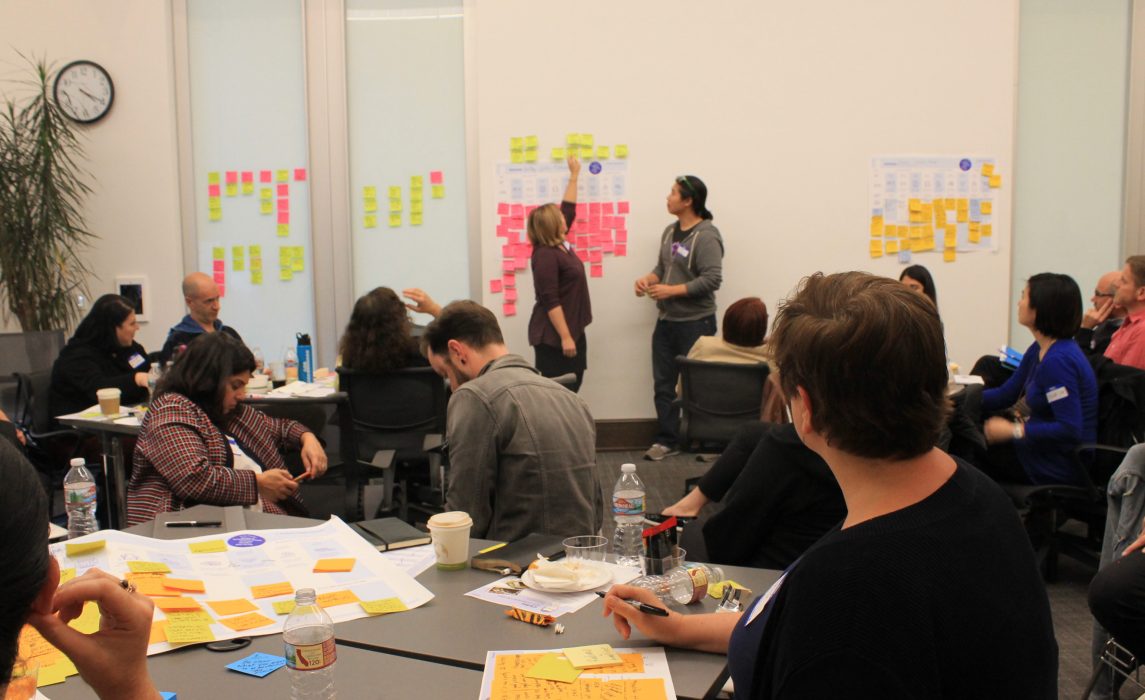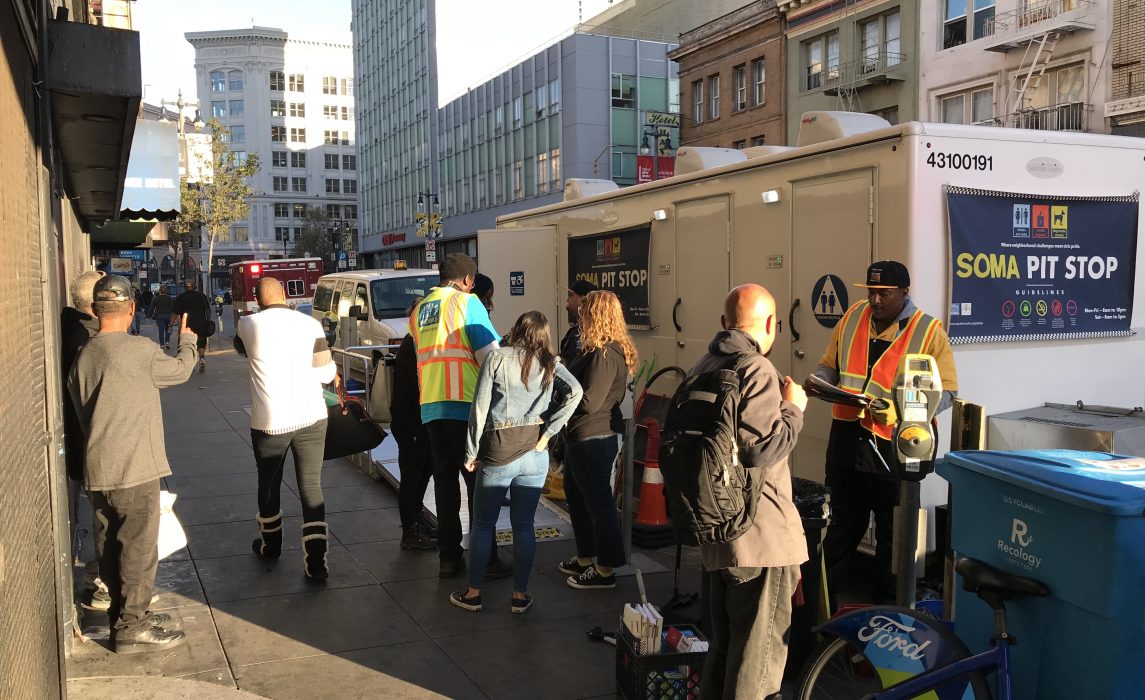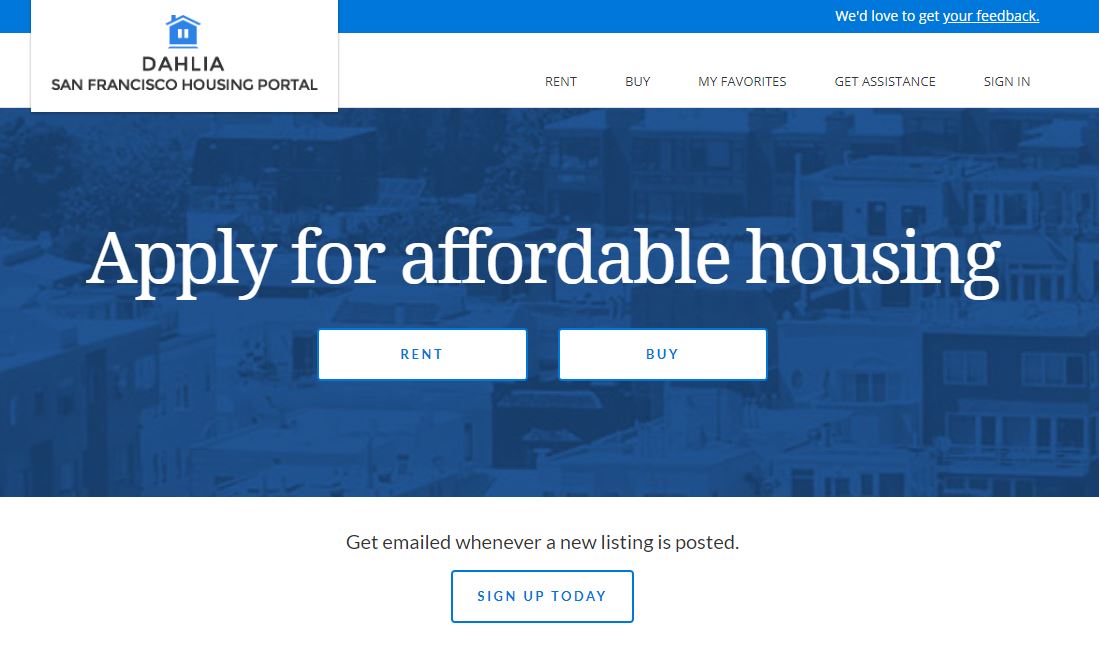Your download is ready. Click here to download.
Background
Cities face numerous challenges that can benefit from leveraging the skills, expertise, and capacity of private sector volunteers. Civic Bridge unleashes the power of skilled volunteers to help solve the city’s biggest problems. By committing time and resources to identifying and scoping projects, Civic Bridge makes it easy for employees from local companies to contribute their time.
Through Civic Bridge, private sector volunteers contribute approximately 20% of their time over a 16-week period, working alongside staff from city departments. The Civic Bridge program management team identifies challenges, matches volunteers with city departments to create project teams, scopes projects, and coaches teams on their work.
Civic Bridge helps city departments partner with a wide range of organizations, including architecture and design firms, technology companies, and consultants. For the city, this can lead to new approaches and solutions to problems, as well as millions of dollars of work completed by volunteers, who, in turn, feel more connected to and invested in their city.
About the Program
San Francisco, like many cities, faces complex challenges like homelessness, affordable housing, and climate change. Although the city had a large number of residents with skills that could be used to support city efforts, it did not have the capacity or infrastructure to manage volunteers effectively. Additionally, companies that wished to provide pro bono services did not know how to engage with the city. In 2015, the Office of Civic Innovation created Civic Bridge, a program that recruits company volunteer teams to contribute 20% of their time over a 16-week period. As of Spring 2019, Civic Bridge had engaged 25 city departments on 49 projects, with approximately 450 city staff and resident volunteers. The city estimates that companies have provided $3.9 million in pro bono work, delivered through more than 24,000 volunteer hours.
How It Works
- Assemble a team of city staff who will coordinate the Civic Bridge program. One to two people can manage the program, including a senior-level staff member, a staff member with user-centered design experience, and individuals who can help with logistics and/or event planning.
- Reach out to city departments to explain the program, give guidance, and gather project proposals.
- Recruit pro bono partners from diverse sectors, such as management consultants, designers, architects, engineers, data analysts, and large private sector companies with diverse skill sets.
- Select projects for the Civic Bridge program and work with city departments to further refine the projects and develop clear challenge statements for each.
- Match the projects with pro bono partners and form project teams.
- Launch the program with a day-long kickoff event with project teams. Explain the Civic Bridge program, timeline, and expectations. The teams should spend the majority of their time scoping their projects and beginning to plan, as well as establishing a meeting schedule and other norms.
- Provide support for project teams during the implementation of the program. Project management should include weekly check-ins for the project teams throughout the program phases: Discover, Design, and Delivery. During these phases, project teams learn more about the challenge, design and test solutions, and deliver recommendations.
- Hold a Demo Day event where each team will present their recommendations to the mayor, department heads, senior company leadership, and other stakeholders.
- Follow up with each city department to ensure that they are implementing the recommendations. Report the impact of the program to participants, city staff, and city residents.
Step 1: Assemble the Program Management Team
In San Francisco, Civic Bridge is administered by the Office of Civic Innovation. While not every city has an equivalent office, city leaders should allocate significant staff time to manage the program. The Civic Bridge program management team provides administrative and logistical support, plans events, and coaches the project teams.
Team members should include:
- A chief innovation officer or equivalent senior level staff member. This team member will be in regular communication with the mayor’s office or other officials about the program.
- A staff member with program management experience. Experience with user-centered design is also helpful, though not necessary. This person will help ensure the teams are employing a user-centered design approach and coach the teams as they scope and plan their projects.
What Makes a Successful Civic Bridge Project
Create criteria that the Civic Bridge program management team can use to evaluate potential projects. These can be refined over time. The criteria should be provided to departments before they submit their projects. Some important things to consider when evaluating projects are:
- A clear challenge statement: What is the problem the department is trying to solve, and what will success look like? If the problem is large, what part of the problem could a volunteer team work on in the alloted time?
- Potential for impact: Why is this project important? What impact will it have on the lives of residents?
- Alignment with priority area: Does the project align with the city’s and mayor’s priorities?
- Leadership support: The challenge should be critical, not just “nice to have” for department leaders. It is important to have the support of the department head to ensure the department can allocate resources and time to implement the project team’s recommendations.
- Internal champion and dedicated resources: At least one internal champion from the city department proposing the project (program manager, analyst, or other subject matter expert) should be identified. This person will lead the engagement and spend at least 20% of their time on the project for its duration.
Step 2: Reach Out to City Departments and Gather Project Proposals
About six months before kickoff, begin to reach out to city departments and invite them to participate in Civic Bridge. You may decide to do a general call to all departments or, if you are focusing on projects within a particular issue or priority area, send targeted emails to specific departments.
Departments may submit projects through an online application form. Set a deadline for submitting applications at least two months before the kickoff event. It is important to have clear criteria for projects to guide departments as they brainstorm project ideas (see above). The application should include the criteria and questions such as:
- What is the problem you are trying to solve?
- What is a concrete deliverable you would like to have completed?
- Why is this important and how is it aligned with mayoral and department priorities?
- What type of skills are needed for this project?
Step 3: Recruit Pro Bono Partners
Begin recruiting pro bono partners about six months before the kickoff event. This should be done at the same time that you are recruiting city departments to participate. When thinking about potential companies or other organizations to contact, consider:
- City priorities
- Organizations with which city leaders want to form relationships
- Existing partnerships
- Public perception of the organization
- Potential conflicts of interest
Invite potential partners to fill out an interest form. The form should include the organization’s basic information; skills they specialize in and/or would like to deploy; and areas of interest, such as transportation, public health, or housing.
Meet with staff from interested organizations to give them an overview of the Civic Bridge program and timeline. The point of contact at each organization should be part of a department that manages employee engagement, corporate social responsibility, or human resources. They should also be a sustainable institutional contact that your city can work with for multiple years. Learn what the organization’s executive leaders are looking to get out of the program, such as staff development opportunities. It is also important to discover the areas of interest of leaders and employees as well as the skills and expertise they can provide.
Step 4: Select Projects
At least two months before the kickoff event, evaluate the projects that have been submitted. This process typically involves several rounds of review.
The Civic Bridge project management team first reviews the projects to narrow down the list as necessary to ensure projects meet the program’s basic requirements. Work with the mayor and his or her staff to identify projects that are a priority for the mayor and the city. A scoring system is a useful way to evaluate projects. Points may be awarded for addressing a mayoral priority, for having an internal champion that can dedicate 20% of their time to the project, and for having a clear deliverable identified.
Projects are then examined by a review committee, which should include city staff knowledgeable in design, technology, budgeting, policy, and data. Ideally, members of the review committee should have experience working cross-functionally with different city departments. The review committee’s primary objective is to ask relevant questions and identify problems and opportunities. The Civic Bridge program management team then makes the final decision, with input from city leaders and the review committee. The number of projects can vary, but make sure it’s a manageable amount for the team.
Step 5: Match Projects with Pro Bono Partners and Form Project Teams
After projects are selected, work with city departments to finalize challenge statements for each project. These are one-page documents that include the following information:
- Project title and city department
- Problem description
- Project goals
- Skills needed for the project (e.g., data analysis, service design, communications, marketing, project management, graphic design, behavior science)
Share challenge statements with pro bono partners and ask them to choose their top three selections, including a short explanation of why they believe the project is a good fit for their organization. It may be helpful to set up calls with partners if they’d like to learn more about the projects before making a selection.
The Civic Bridge program management team evaluates which projects match each pro bono partner and decides on final matches. Once matches are made, you may wish to have partners sign a volunteer agreement. Be sure to notify companies and organizations that are not selected to participate in the program and invite their feedback.
Each team consists of pro bono members and at least one member of the department staff, including an internal champion who could be a project manager, analyst, or subject matter expert.
After projects have been assigned, work with each city department to create a project brief, which further defines the challenge and ensures teams have sufficient context and clear goals. The project brief may include:
- Project scope
- Key questions for project team to answer in order to better understand the problem. For example, how do different stakeholders describe the problem?
- Stakeholders and users
- Project goals
Provide a brief orientation for pro bono teams, either in person, over the phone, or as a webinar. Share materials, including the project brief and timeline, so that volunteers are prepared for the kickoff event.
Step 6: Launch the Program with a Kickoff Event
The kickoff event begins the 16-week period when the project teams, including department staff and volunteers, work together. The event is a chance to walk through the Civic Bridge program and for project teams to begin to plan. You may also wish to invite a speaker to talk about the importance of collaboration.
Start preparing for this meeting at least two months ahead of time so that the Civic Bridge program management team has plenty of time to book a space, find a speaker, and prepare materials and slides.
During the event, make sure to:
- Thoroughly explain the Civic Bridge program and timeline
- Establish working norms, including team member responsibilities, meeting schedule and location, how teams will prepare for meetings, and response-time expectations
- Allow teams to further scope their projects. This includes building on the project brief to agree on the problem statement, define deliverables, and identify stakeholders
- Share goals with the teams
Step 7: Support Project Teams During Discover, Design, and Delivery
The 16-week collaboration period is divided into three phases: Discover, Design, and Deliver. During the Discover phase, which lasts about six weeks, the project team conducts research to learn more about the problem; speaks with stakeholders, clients, and users; and creates a project plan.
The Design phase lasts about four weeks. Project teams apply what they have learned in the Discover phase to design potential solutions; test their recommendations by presenting them to department staff, stakeholders, and users for feedback; and refine their recommendations based on feedback.
The Deliver phase lasts about six weeks, during which project teams test and refine recommendations, create implementation road maps for the city departments, and prepare for Demo Day.
Project teams meet weekly and handle the majority of their own logistics. A member of the Civic Bridge program management team should attend weekly meetings to answer questions, help with project management, and keep teams accountable and on schedule.
While the Civic Bridge program management team should check in regularly with project teams, a longer check-in at the midpoint is a useful milestone and chance to assess projects. Questions you may want to ask include:
- Are you on track to complete the project within the projected timeline?
- Do you have the information you need to move forward?
- What has been most exciting part of this experience so far?
- Have you run into any unexpected challenges?
- What other resources could be useful to you?
You may also wish to give project teams a chance to present what they have learned and their design ideas to other teams about halfway through the program. Each team can give a short presentation (about five minutes) and receive feedback from the other teams.
Near the end of the 16-week period, it is helpful to hold a planning call with project team members to make sure they have a clear plan to help the city department implement the team’s recommendations.
Step 8: Hold a Demo Day Event to Present Recommendations
Demo Day is an opportunity for project teams to present final recommendations to the mayor and other stakeholders. It also provides a chance to celebrate the program and recognize volunteers and partners.
Make sure to plan well in advance in order to find a venue, order food if necessary, and invite participants. Invitees may include the mayor; pro bono partners, including past and potential partners; Civic Bridge volunteer alumni; and press, if desired.
In advance of Demo Day, you may wish to conduct a workshop to help project teams prepare slideshows and remarks for presentations.
Step 9: Follow Up and Report Impact
Follow-up is essential to ensure that Civic Bridge projects generate results. About six months after Demo Day, schedule a meeting with city department staff from each project team to discuss how implementation has progressed. This is an opportunity to understand what made implementation successful or challenging and to learn more about the quantitative and qualitative impacts of the team’s final recommendations.
Some questions you may wish to ask include:
- What do you think has worked well? Where is there room for improvement in the overall structure of the program?
- How would your department have tackled this challenge if Civic Bridge were not an option?
- When you finished Civic Bridge, did you have a clear plan for moving the recommendations forward?
- What, if any, obstacles have you encountered while working to implement the recommendations?
- It’s been six months since the program ended. What stories could you share about the impact of the Civic Bridge deliverable in your department and in the community? What are some of the quantitative metrics that illustrate the impact?
It is important to report the impact of the program back to participants, city leaders, and the wider community. Some metrics the you may want to track include:
- Number of participants and total hours contributed
- Estimated value of time donated
- Number of departments and city staff that participated
- Number of people who have used services or initiatives as a result of the project
Qualitative results are also important. These may include case studies about recommendations that have been implemented, stories from participants, and stories from residents who have benefited from new or improved initiatives and services.
Share results widely on the city website, in newsletters and social media, and with partners.
Civic Bridge in Action
DAHLIA: A New Affordable Housing Portal
When San Francisco’s Office of Civic Innovation began the Civic Bridge program in 2015, creating a better system for the affordable housing application process was a perfect fit. Affordable housing is a key priority for the city, so this project had support from many city leaders, including a champion in the Mayor’s Office of Housing and Community Development, Maria Benjamin. The project had the potential to impact thousands of lives.
Gathering Project Proposals: Affordable Housing
Like many cities, San Francisco was working to alleviate its affordable housing shortage, but the application process for existing units was fragmented, confusing, and time-consuming. Residents often had to go to several different locations to fill out applications, sometimes spending hours in line to submit their forms. The applications for each location were different and required extensive amounts of information. Then a lottery took place and it was difficult to figure out whether or not your lottery number was selected. If you weren’t offered a unit, the process started all over again for your application to the next building.
In addition, the Mayor’s Office of Housing & Community Development (MOHCD) was having trouble keeping up with new housing that was added to the system.
Recruit Pro Bono Partners: Google
The Civic Bridge program management team knew that the Google pro bono team would be a great partner for the project.
“When we scoped out the challenge, we didn’t want to be prescriptive with the team,” said Krista Canellakis, Chief Innovation Officer for San Francisco. “The team from Google came in and brought their user-centered approach to the way that they deliver products to this project.”
Google typically looks at a few criteria when evaluating which Civic Bridge projects to take, explained Jen Carter, Product Manager and Head of Technical Team for Google.org. These include things like whether the project requires complex technical skills, whether it will result in a scalable and sustainable solution, and whether the team has capacity.
“We really focus where we think Google and Googlers can add unique value,” said Carter. “And I think this project really allowed us to do that.”
There are several benefits to Google and other companies that participate in Civic Bridge. It’s a way for organizations to develop leadership, cultivate public goodwill, and help staff feel good about the work they are doing.
Understanding the Problem
City staff in San Francisco’s Office of Civic Innovation spent time scoping the problem, like they do for every project. Once the project began, the Google team worked with city staff from MOHCD to delve deeper and learn more about the problem.
MOHCD gave the project team lists of community centers to visit, addresses of affordable housing complexes, names of housing counseling agencies, and other stakeholders. Using these lists, Google employees spoke with dozens of people, including affordable housing developers, residents who needed to apply for affordable housing, and city staff.
“For the residents, it was incredibly difficult and complex to find and submit an application for affordable housing,” explained Carter. “But then it wasn’t just residents that were having the problem. City staff was taking a ton of manual effort to review applications.”
The project team helped MOHCD better understand how long it took for residents to complete the applications. The project team mapped the complicated journey that affordable housing applicants had to go through, identifying frustrations that residents were encountering, such as confusing terminology and separate processes for each housing application, each with a different set of requirements.
Throughout this process, the Civic Bridge program management team provided hands-on support.
“Because housing is such a priority for our city, our team was really heavily engaged on the project to make sure it was staying on track,” said Canellakis. This included helping the team meet deadlines, facilitating information gathering, coordinating volunteers and stakeholders, and translating tech sector and government jargon.
“Our role is really to have knowledge of all of those things so that we can ensure that the project is successful and meets the goals that it says it’s going to meet,” said Canellakis.
Making an Impact: DAHLIA
After gathering a considerable amount of information to understand the problem, the team developed prototypes for an online system and did user testing with potential applicants and city staff. Using the feedback they received, the project team mapped out how a new system should work and the features it should have, which included a listing of available housing, tools for developers and housing counselors, and news about upcoming housing lotteries. They also created a timeline that MOHCD could use to create the new system, including finding and securing a software developer, testing, and launching the new portal.
Now, 97% of applications for affordable housing in San Francisco are submitted through the new housing portal, called DAHLIA (named after the official city flower). The amount of information required from residents has been cut by up to 75%, making it much easier for residents, developers, city staff, and housing counselors to manage affordable housing applications.
“This is a city that cares about people having equitable access in all levels, so of course DAHLIA is beautiful,” said Benjamin. “I really believe that DAHLIA has already changed the relationship between the Mayor’s Office of Housing and Community Development and the public.”
The success of the project has also encouraged other city departments to participate in Civic Bridge. One recent example is a new system, currently in development, to help the city comply with new right-to-counsel legislation. The system will provide referrals for free legal counsel to residents facing eviction.
Civic Bridge also impacted the Google volunteers and changed their relationship to the city. “I feel closer to the city.” said Lauren Jong, a Google employee who participated in the project. “I feel closer to all the people who live here, as a community.”

